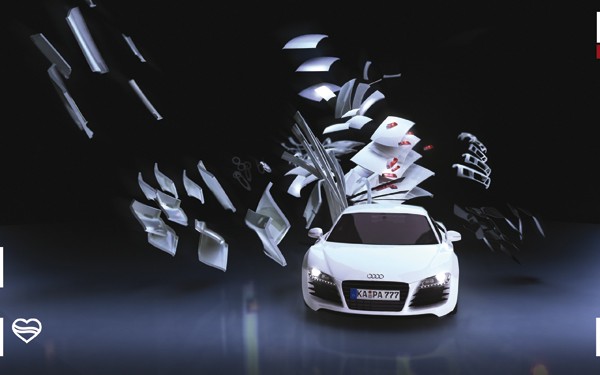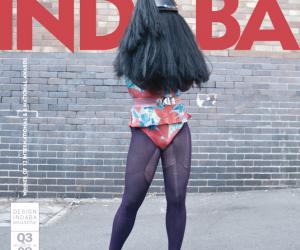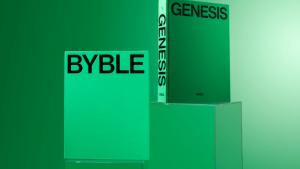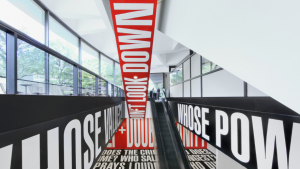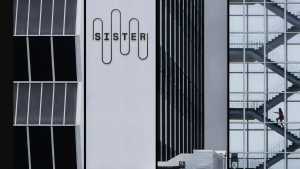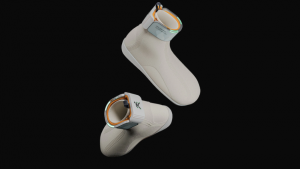First Published in
"Design is what makes our work stand out and look different, and this adds value to any production," says Anthony Dart, founder of Jo'burg-based design and animation studio Ontwerp.tv. Over six years old now, Ontwerp.tv has brought their multimedia skills to the assistance of a range of high-profile brands including Sony Ericsson, Seat, Boardmans, Edgars, Tang and Ford. However, what has distinguished their work and driven their appeal beyond the boardroom, is the studio's massive output of work done for, well, the heck of it.
"Ontwerp.tv was founded on a sense of truly loving what we do, it was that simple," Dart explains. Design Indaba quizzes him about constant creative rejuvenation and finds out that it's more about being incorrigibly curious, roguishly technical and passionately futuristic than chasing money, fame or even hipness.
Who is Anthony Dart?
I am the founder of Ontwerp.tv.
Random thoughts and memories: I grew up in a lot of different places. I remember Pinetown, Durban, where my dad had chickens that after being beheaded would run around in a strange and random dance, reanimating until they unwound into a pile of feathers. Also Noordhoek in Cape Town where, at age 10, catching the train to school, I split my head open on the platform because I thought I could jump off a moving train. I just remember waking up with my brother poking me and a perfect circle of people gathered around.
As far back as I can remember I have loved to draw while listening to my mom's extensive vinyl collection. I'd space out to Dark Side of the Moon or play video games on our new Atari console. Then there where my high-school days in East London where I got "jacks" for skateboarding on the war memorial and discovered my love of the outdoors, reading and writing. My parents had split and I was living with my dad, surfing at Nahoon Reef and skateboarding every other day.
When I matriculated it was time to figure out what to do and I thought I was going to be a fine artist or an illustrator. There wasn't anywhere to study back then unless I went to Grahamstown, but my dad was against my studying art, saying I would die poor and that I needed to get a real job. So I moved up to Jo'burg to stay with my mum and to find a place to study on a very limited budget. I settled for studying Fine Arts, Graphic Processes and Photography at Parktown College. I spent most of my time drawing my favourite characters from graphic artists like Simon Bisley - especially 2000AD and ABC Warriors - and also developed a lasting obsession with photography.
One of my first jobs was making signage for the exhibition industry, which meant spending all day cutting giant letter shapes and logos out of vinyl, first by hand and later by plotting them on computer. So, between screen printing at college and cutting out giant vinyl letters, I think I developed a love for a bold flat treatment that had an impact on my typographic style in later years. The company soon diversified into making large-format colour prints and got a Mac with Photoshop and Bryce 3D. This was a turning point for me, defined by a furious dedication to learning every new piece of software that I could lay my hands on.
I jumped around a bit and ended up at Lowe Lintas (now Lowe Bull) where Rob McLennan (now at Net#work BBDO) was my creative director. This was where I started getting into 3D, Flash and eventually After FX. Once I realised that the converging tools let me take my creativity to new heights, I was hooked - shooting stills and scanning them in, incorporating hand-drawn elements, modelling all kinds of objects in 3D, doing stuff in Photoshop and finally compositing it all together in After FX.
That's when I truly knew what I wanted to do. I had never really seen myself as a designer but it was the Internet that fuelled my love for design and it became a virtual classroom for me. Everything I taught myself about design came from the 'net and books like Josef Müller-Brockmann's Grid Systems.
What is Ontwerp.tv?
Ontwerp.tv was founded in early 2002 after I had become disillusioned with working for a boss. For a while it was just two of us in a tiny office in Randburg where we strung about 10 machines together on a switch so that we could manage the entire production process from design to compositing and finally rendering. One thing I find remarkable, thinking back on those days, was the sheer amount of volume just two guys would push out. We worked around the clock a lot of the time to meet our ever-shortening deadlines. But it soon became apparent that producing the work as well as doing all the administrative stuff was becoming unrealistic and when it started affecting our output I started hiring more people who shared a likeminded passion and vision. We started out primarily doing broadcast stuff but as the software revolution exploded we quickly diversified into commercials and effects work as well as audio.
What do you mean by a "no-school approach to technology"?
It's that whole self-taught self-motivated mentality - something we share as a collective. For example, in 2004 I got a brand new Mac Powerbook and it had a piece of software on it called Garage Band, which is a basic DIY music production tool capable of recording and mixing audio with a full set of virtual instruments. I knew nothing about music production but I just immersed myself in it. From there I moved onto Logic Pro, Soundtrack Pro and Reason in a makeshift sound studio that I set up at home with a whole bunch of old synthesisers, guitars and field recording devices.
Does this rogue attitude explain your broad range of output from corporate identity to animation, design and even music?
Yes. I love creating an environment where anything is possible and if one of my guys mentions to me that they want this new plug-in or new piece of software, then I get it. I think it is quite important to surround myself with likeminded individuals who enjoy trying new things all the time and it's one of the most rewarding parts of what we do - we are always combating the mundane by trying out new stuff. Doing everything from print to commercials to new media applications makes it fun and it's great for our clients, who can benefit from a broad skill-set under one roof.
What are your favourite projects and why?
A lot of our favourite work is where we are left to our own devices. If too much time elapses in between jobs, we inevitably create our own internal projects and collaborations, where we can break free from the restrictions of corporate work. Restrictions are good, obeying the rules has its place just as breaking them does, but we find it critically important to satisfy our innate curiosity and stretch ourselves to experiment with new workflows and projects.
The Lark Moonlight video was a real opportunity at a time where we were struggling to break into more high-end work, being done by primarily large production houses. Director Greg Rom (Humanoid from Egg Films) approached us after I had expressed a keen interest in doing a collaborative project together. All he said was that he was working on a treatment for a new band from Cape Town. When he played us the song, we were blown away immediately.
Where does Ontwerp.tv's trademark look of eerie futurism mixed with grungy nostalgia come from?
People have always asked me that - why is your stuff so dark? I guess that eerie dark tone has always resonated with me. When I was a boy I watched 2001: A Space Odyssey and The Shining, then much later Chris Cunningham's music video for Bjork's All Is Full of Love and the Aphex Twins's Come to Daddy videos. Since I can remember I have had a healthy fascination/obsession with sci-fi and horror films. So it comes from what I watch, what I listen to and what I read. I love the analogue aesthetic - a mix of lo-fi and hi-fi is in everything I do, from music to design. Besides, I think it humanises the technology aspect of our tools, in an industry that seems more often than not to be about the software and not the work. We want to keep a healthy balance of both.
Your work does diversify when it comes to corporate work though?
Clients are very specific about what they want and a lot of the time they give you a concise reference of what they would like to achieve. This leaves us little room to be as innovative or as inventive as we would like, although we try to push it as much as we can. Another factor to consider is that deadlines are getting shorter and budgets are getting smaller. Still, there are those rare occasions where clients are more open to experimental graphic treatments, which is when we are in our element. We also aspire to treat each new job as an opportunity to try something new stylistically or aesthetically whenever possible. Bearing this in mind, the challenge is placing your own stamp on the work as well as giving the clients what they are after.
What are the current trends and ideas in motion graphics and technology that are influencing you?
Super convergence in technology is fast becoming a reality. I recently got an iPhone with which I can make calls, send SMSes, check my email, browse the web with Safari, find any location with Google maps, zoom into Central Park in New York or quickly pan over my neighbourhood to look for empty swimming pools, listen to the latest album I'm into, view photos, show someone our latest reel and it all syncs with my Mac.
The television and Internet are already feeling the impact of these tectonic collisions. The swapping of South African broadcasting from analogue to high definition digital means we can have a lot more channels, for less bandwidth and it's all scheduled for 2015.
I'm heavily influenced by this singularity concept (a point in the future often set at or around 2030) beyond which overwhelming technical changes (especially the development of superhuman artificial intelligence) make reliable predictions impossible. So we will soon be replacing all our devices for one device that does everything, connecting us all, as well as isolating us like never before.
Other than technology, I'm influenced heavily by nature, which creeps into all my work like an organic virus. I love manmade and natural pattern correlation and the ambiguous forms in between, like sculpture, music and architecture.
What are the challenges that small motion graphics agencies face in South Africa?
Around six years ago when I first started Ontwerp.tv, it was super-tough to break into the motion graphics scene because it was monopolised by large established post-production companies. But the advancement in desktop computing and post-production processes em-bracing HD and tapeless workflows provided the new, up-and-coming studios an opportunity to partake in a furiously competitive industry. It's not that different to a lot of other industries where you have more companies all competing for the same market share.
Why Johannesburg?
Jozi may have its problems but it has a great energy that the people who live here simply love. Sure we are wound a little tighter but I think it improves our work ethic. The city has a great magnetism and benefits from a rich cultural diversity that impacts greatly on our creative scene.


